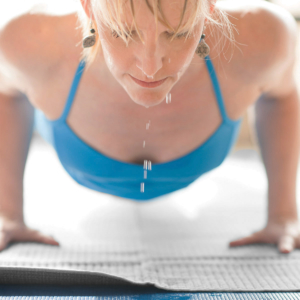 As the year comes to a close, most of us have one major priority: finding just the right gift for each person on our list. A close second could be finding a way to maintain fitness while navigating the season’s traditional celebration of copious amounts of food.
As the year comes to a close, most of us have one major priority: finding just the right gift for each person on our list. A close second could be finding a way to maintain fitness while navigating the season’s traditional celebration of copious amounts of food.
The key is to remember to move our bodies, even as we enjoy our holiday treats. But the weather can be a bit nippy for a brisk walk. So why not warm up AND move your body by trying a Hot Yoga class?
Most Hot Yoga classes take place in a room heated to 104 to 105 degrees—serious heat. In Hot Yoga, your core temperature rises and your heart rate increases. The average male practitioner can expect to burn about 460 calories in a session, while the average female practitioner might burn around 330 calories, according to a study published in Time Magazine.
Hot Yoga is not for everyone, but for those who love to sweat, it could be the thing that carries you through December and beyond. It can be intense though, so here are some tips to help you ease into the practice. Several of these tips apply to all types of yoga, so even if you don’t plan to practice Hot Yoga, there’s something here for you.
- Arrive early. It can be helpful to get to the studio 15 minutes early to allow your body to acclimate to the heat before you start moving. Hot Yoga classes are pretty vigorous. It’s important to give your body time to make a smooth transition into practice.
- Give your body a good two hours to digest a meal before practicing. This applies to all types of yoga, but is especially important for practicing in a hot room.
- Hydrate. Because you will be sweating a whole lot, make sure you hydrate before, during and after your practice. Water is good, but it’s important to replenish electrolytes that might be lost as well. So drink lots of water, but make sure you supplement with electrolytes.
- Rest when you need to. It’s common, especially for beginners, to feel some combination of light-headedness, nausea, confusion or muscle cramping. If you encounter any of these symptoms, stop and rest. Sit on your mat and breathe slowly and evenly through your nose. Take as long as you need. Don’t feel pressured to “perform.” Yoga is not about performance; it’s about caring for your body, and sometimes sitting and resting is the best yoga.
- Don’t push it. The heat in the studio just might enhance your soft tissue flexibility. if you find that you’re more flexible than you’d thought during practice, take care with how far you push your body. Pushing past your normal range of motion can cause ligament laxity, which can, over time, destabilize your joints. Take it easy. Stay inside your body’s limits.
What to Bring
- A moisture-absorbing mat. Many nonskid yoga mats repel moisture. This can make them quite slippery if you’re sweating. Our Sattva Jute Mat is part PER, part jute fibers. The jute fibers provide extra texture and a bit of absorbency. Our Hot Yogi friends say this mat is great for Hot Yoga practice. Spot clean with a damp towel.
- Bamboo Towel. Some people find that combining a nonskid mat with an absorbent towel or rug works best for them. Our Yoga Towels provide a stable, absorbent surface for practice. The front surface is a soft, textured surface for traction, while the back surface is covered with nonskid material that will stick to your yoga mat. You can machine wash these towels (no bleach or fabric softener) and hang to dry.
- Cotton Yoga Practice Rug. As an alternative to our Bamboo Towels, some yogis prefer to practice on a Cotton Yoga Practice Rug. A staple of Ashtanga Yoga, these rugs also provide an absorbent surface. Because of their thickness, these rugs resist bunching up on your mat. Hand wash and hang to dry.
- A nonskid mat for under your Bamboo Towel or Yoga Practice Rug. For safety and stability, it’s important that your Bamboo Towel or Yoga Practice Rug be placed on top of a nonskid mat. Our Hot Yoga experts have chosen two mats they like for this purpose, although any of our nonskid-type mats would work. Here’s what the experts recommend: Para Rubber Yoga Mat, an extra grippy, 1/4-inch-thick, heavy-duty mat; or Tapas Travel Mat, an ultra-thin, economical choice that gives you more direct contact with the floor.
- Mat wash. Whatever surface you choose, your mat will get sweaty—guaranteed. You’ll want to clean it after you practice. Bring a small hand towel and a bottle of our PureMat Mat Wash in lemon or lavender.
